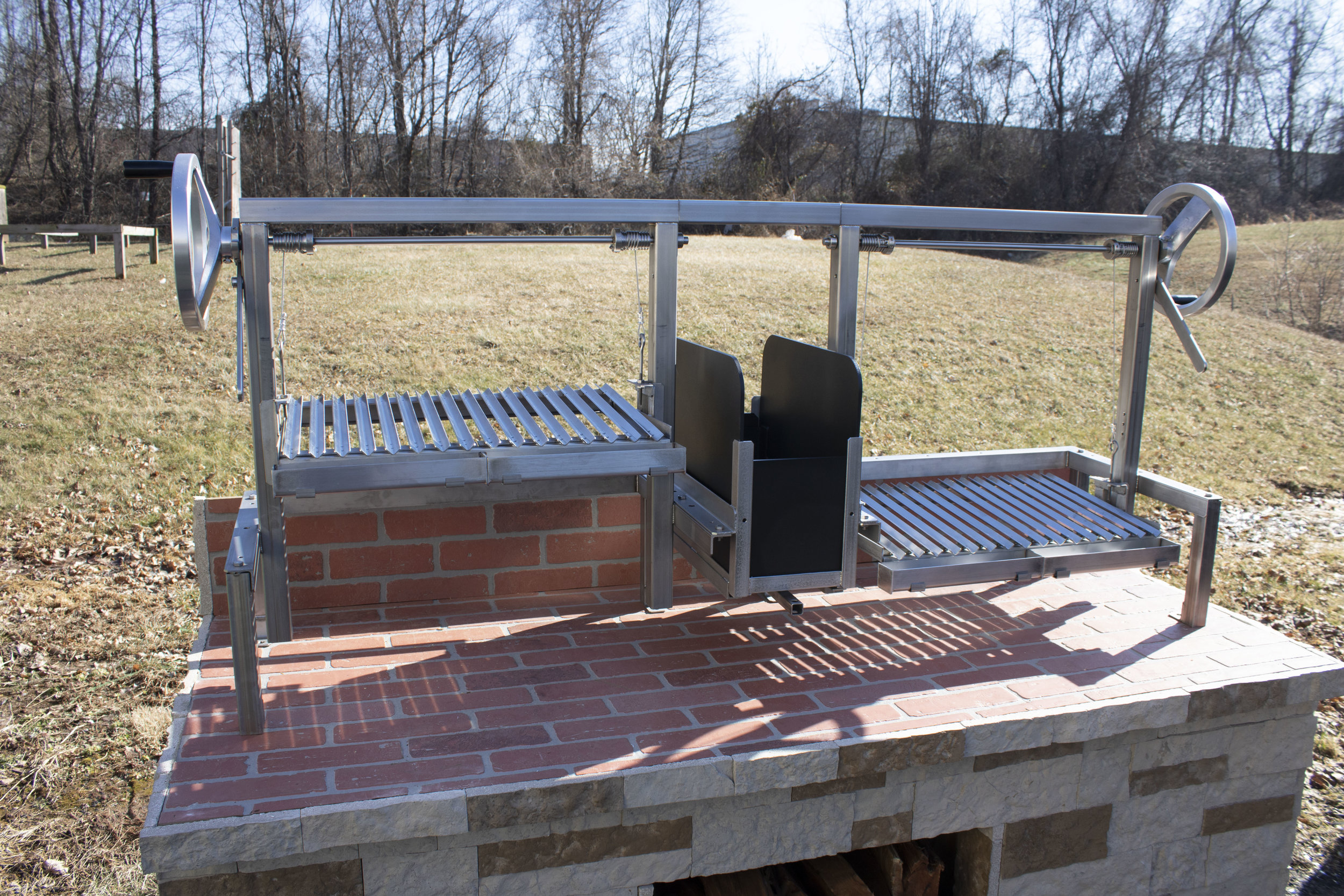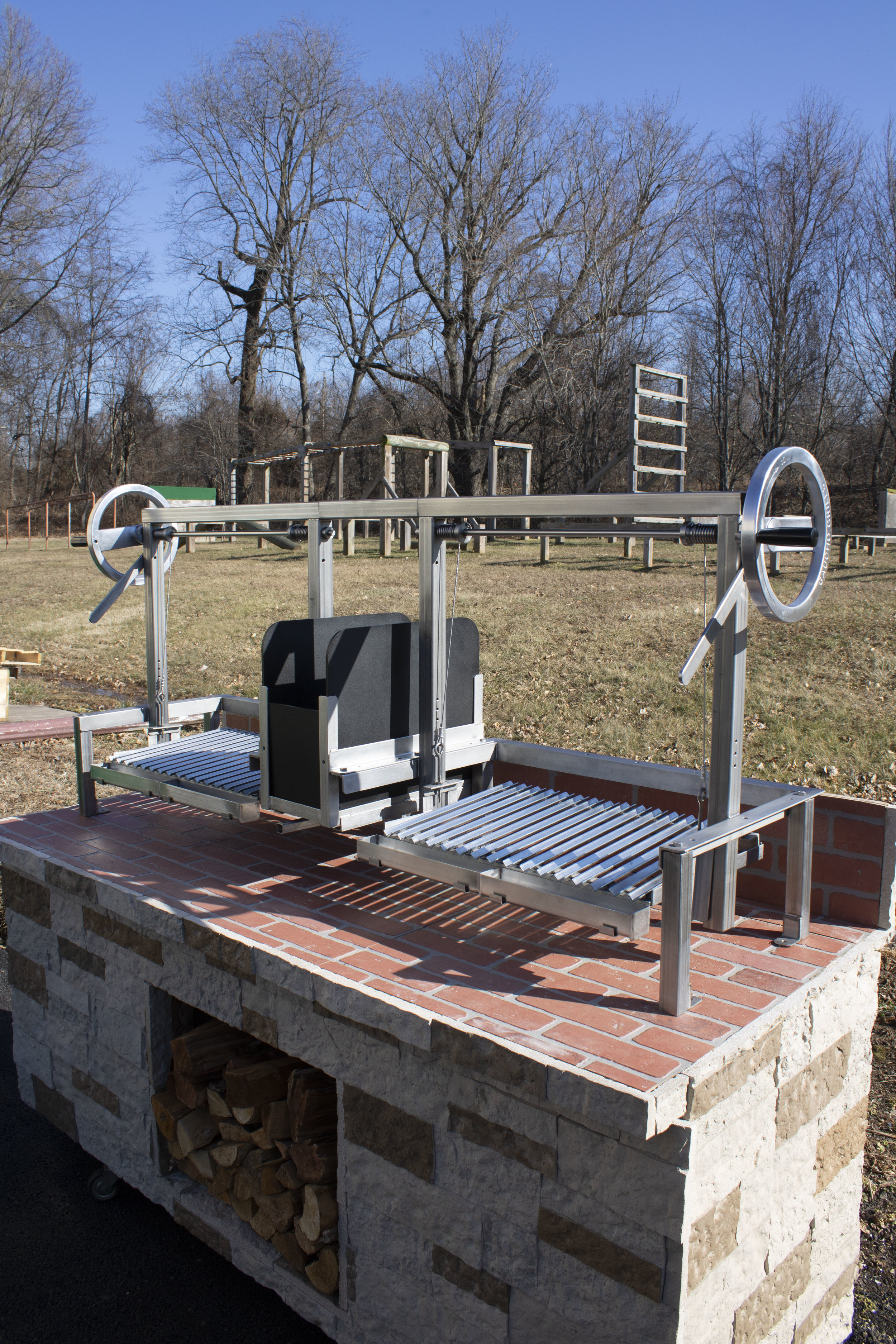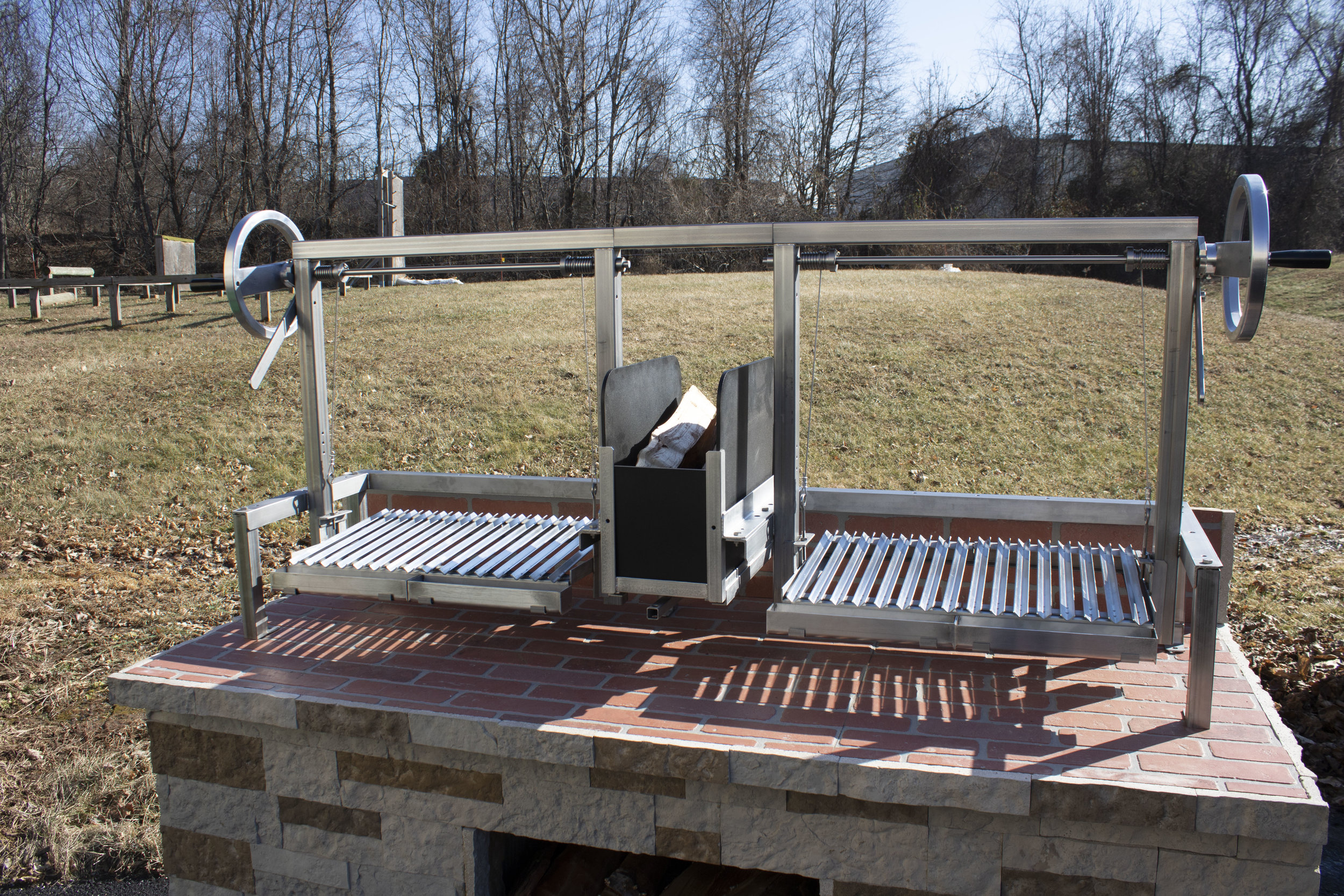Packing up and getting ready to ship this Gaucho sized insert to Maine. Grills are heading out the door to complete outdoor kitchen projects in time for the Spring grilling season.
Custom Double Grill
We love grills, but in our hearts, we’re engineers. So when we get the chance to build something wild like this custom double grill/single brasero, we jump at it. With two Gauchito sized grills, independent cranks, and our sturdy brasero in the middle, it’s ready for anything you can throw at (or on) it.
Interested in your own custom grill? Check out some ideas here, and then contact us!
Meat Cutting Techniques & Tips
We’ve designed our Argentine grills to give you perfectly cooked cuts of meat. What you do with that meat after it leaves the grill is up to you. The way you cut a steak after it’s cooked plays as much of a role in your meal as the grilling process.
When you’ve taken the time to grill a nice piece of beef on your parrilla, you want to make sure that you take the proper steps to serve it correctly. Here are a meat cutting techniques and tips that will allow you to get the most out of your next meal.
Argentine Grilling Marinades: Chicken, Steak & Seafood
In our last blog post, we talked about the mystery of where chimichurri got its name, as well as some of the misconceptions about this sauce.
(For example, it’s not “Argentinian ketchup.”)
There seems to be some debate online about whether chimichurri should only be used as a condiment, or can also function as an Argentine grilling marinade.
“While some recipes for chimichurri use it as a sauce, using it as a marinade opens up new flavors and tenderizes less tender cuts of meat,” writes Kathie Smith of The Blade. “In order to tenderize, a marinade must contain acidic ingredients such as lemon juice, yogurt, wine, or vinegar, or a natural tenderizing enzyme found in fresh papaya, ginger, pineapple, and figs, according to the National Cattlemen’s Beef Association.”
So today we’re going to talk about marinades, by offering two different recipes for a marinade you can make the next time you’re ready to grill.
Using Your Asado Rotisserie Grill Attachment
Our company’s name is Gaucho Grills, but you can use our products for more than just grilling.
You can buy one of our grills with a rotisserie grill attachment, which snaps in place with just a few quick steps. When you watch this video, you’ll see that it takes less than a minute to make the switch from grilling to rotisserie.
Simply lower and remove the V-groove grill grates, detach the grease trough and attach the rotisserie bar, and you’re ready to cook.
And when you cook rotisserie style, you’re engaging in a time-honored method of food preparation enjoyed all over the world, from people in Greece spit-roasting lamb to the delectable babi gulig (spit-roasted pig) found on the island of Bali to the American traditional backyard barbecue.
No matter how you cook, there’s something about cooking around a fire that brings people together, and there are many foods that seem designed for a rotisserie grill:
Ribs
Whole fish
Rounded foods like turkey breasts, boneless legs of lamb
Duck
Chicken
Prime rib
Artichokes, eggplant, squash, potatoes and other vegetables.
Fruits such as pineapple (your rotisserie can even make dessert!)
So what should you cook with the newly-installed rotisserie?
Glad you asked. As always, we’re happy to share some recipes.
Vegetable Dishes and Sides for Your Asado Meal
“When we think of Argentine cuisine, we think of beef.”
Those were our words, about three months ago, right here on this blog.
And if you read most of our entries here, you know we love the idea of grilling a nice, juicy steak or a succulent piece of chicken.
But while meat might be the star of your cookout, it still needs its supporting cast. (You’ve also got your vegetarian guests to consider.)
With that in mind, we’ve put together a few suggestions for vegetable dishes and sides you can serve with your next asado meal.
The Benefit of Grilling on V Groove Grill Grates
It’s time to make your world class burger. The 80/20 Beef has been prepped and formed. Your parrilla grill is hot. The grilling starts out great, the smells and sizzle indicate you got the start you’re looking for. But it doesn’t take long to put you back into a familiar panicked battle; How to keep your gourmet burgers from becoming smoldering hockey pucks!?
Grilling with your Himalayan Salt Block
Although used for thousands upon thousands of years, (See the Book of Job reference) today it seems like the use of salt has exploded in popularity more than ever. Try to find a seasoning or condiment that doesn’t advertise: “Made with all-natural sea salt.” Look and see how many pretty salt colors and flavors there are in your local spice shop or even grocery store. There are colored salts, flavored salts, smoked salts, salt cured meats, salt encrusted meats and fish, and on it goes. It’s even a hit in our desserts and coffees with “Sea-Salt Caramel” flavored everything.
So it was no surprise to us when we discovered the wonderful world of salts has now permeated into the grilling arena. Yes there are a thousand and one ways to season any of your grilled fare to perfection with salts. Recipes abound that call for all sorts of extravagant salted marinades and rubs. In addition, there perhaps is no better way to prepare a juicy grilled steak than to season it with a minimalist approach of some coarse kosher salt and cracked black pepper. However we’ve recently come to embrace the fantastic salt infusing method of grilling on top of a Pink Himalayan Salt Block. For a salt lover, this is truly a unique way to go.
The Origins of Asado Style & Parrilla Grilling
When we think of Argentine cuisine, we think of beef. The Spanish brought cattle to Argentina in the 1500s, and beef has been a key part of the national cuisine ever since.
But just as important to this equation is the asado.
We’d call it “the Argentine version of the cookout,” but that only sort of does it justice.
It’s actually a practice that goes deep into the country’s history, men known as gauchos—legendary cattle wrangling figures – cooked their meals on makeshift grills which were the original parrilla grills.
Beef Ribs Recipe – Tira de Asado
Ribs are a staple of the barbecue menu, no matter the hemisphere in which you find yourself dining.
But the way we prepare ribs in the U.S. and the way they’re made in a country like Argentina are two very different things.
When we make ribs here in America, we tend to cook them using a slow roast and a lot of basting.
Cook Like a Gaucho With These Argentine Style Grilling Tips
“Asado” is a term used in Argentina and other South American countries that means “barbecue,” but it doesn’t quite describe the way you do your standard outdoor grilling.
This is meat cooked over coals or wood embers, a system developed by Argentinian gauchos who needed to grill their food out on the grasslands.
It’s not a cooking method for everyone, but if you think you’re ready to tackle it, here are a few Argentine style grilling tips from Manuel Debandi, chef at the Terrazas de Los Andes winery
The Inspiration Behind Gaucho Grills
What do machine design, precision machining, outdoor grilling, and love of all types of food have in common? They are all the passions of one entrepreneur, who decided to encapsulate all his interests into a new business.
Gaucho Grills is the culmination of the hobbies, interests and experiences of Edward Pentz, an Argentinean born mechanical engineer, who immigrated to the United States 47 years ago and started his own precision CNC machining business. Founded in 1986, Ed’s company, EMP Industries Inc., has been providing machine design and prototype services, CNC machining, fabrication, and assembly services to the semiconductor, electronics, medical, and consumer products industry for over 27 years.















